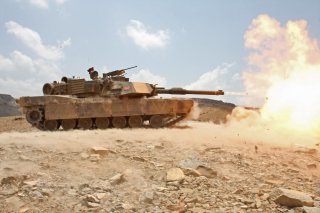Are Tanks Headed for the History Books?
America's marines are preparing for a different kind of warfare.
Here's What You Need to Know: The Corps would add scores of rocket launchers, new high-tech communications systems, and lots and lots of drones, to replace tanks.
The U.S. Marine Corps wants over the next 10 years to eliminate all of its tanks, a third of its tube artillery, some amphibious vehicles and aircraft as well as thousands of infantry and other personnel, all in an effort to reshape the service for island warfare in the Western Pacific.
In their place, the Corps would add scores of rocket launchers, new high-tech communications systems, and lots and lots of drones.
If lawmakers approve it, the proposal could result in the most sweeping change in decades to the Marine Corps force structure. The service would cut 12,000 people from its ranks, shrinking from today’s roughly 220,000 active and reserve Marines to around 208,000.
“The Marine Corps is not optimized to meet the demands of the National Defense Strategy,” Maj. Joshua Benson, a spokesman for \Marine Corps Combat Development Command, told USNI News.
“In the summer of 2019, the Marine Corps began force-design activities focused on adapting capabilities to properly shape the Marine Corps’ contributions to naval warfare and the joint force. These planning efforts led to a modernized design that incorporates emerging technologies and significant changes in force structure to deliver a Marine Corps the nation needs by 2030.”
The proposed cuts, which Marine Corps commandant Gen. David Berger has championed, might appear to be draconian. “By the year 2030, the Marine Corps will see complete divestments of Law Enforcement Battalions, Tank Battalions and associated Military Occupational Specialties and all Bridging Companies,” Benson explained.
“Additionally, the Corps will reduce the number of infantry battalions from 24 to 21; artillery cannon batteries from 21 to five; amphibious vehicle companies from six to four; and reduce tiltrotor, attack and heavy-lift squadrons,” Benson said.
The Marine Corps also wants to shrink some F-35 squadrons, reducing their complement of stealth fighters from 16 planes to 10.
Observers expected the cuts. While extricating itself from the air- and ground-wars in Iraq and Afghanistan, the Marine Corps is working with the U.S. Navy to realign toward so-called “great power competition” with China.
To help deter China from expanding across the Western Pacific and defeat Chinese forces in battle, the Marines have created a new operating concept. Instead of storming enemy beaches from specialized vessels and fighting infantry battles ashore, the Corps would deploy from collections of cheaper support ships in order to establish airfields for F-35s and fire bases for anti-ship rocket batteries.
There arguably is no place in this new Expeditionary Advanced Base Operations concept for tanks and other armored vehicles and short-range tube artillery. The need for infantry shrinks, too.
On the other hand, the demand for long-range rockets, drones, and communications could spike. With the money the Marines save from cutting tanks and infantry, Berger wants to triple the number of wheeled High-Mobility Artillery Rocket System launchers and double the number of drone squadrons.
The Marines are rushing to arm the HIMARS launchers and other vehicles with new anti-ship missiles. The Corps also is buying ground-launched Tomahawk cruise missiles with special seekers for targeting ships.
“Moving forward, we will continue to judiciously evaluate, wargame, experiment and refine our force design, improving service capabilities and lethality for deterrence, competition, and conflict,” MCCDC stated.
David Axe served as Defense Editor of the National Interest. He is the author of the graphic novels War Fix, War Is Boring and Machete Squad.
This article first appeared in March 2020.
Image: U.S. Marine Corps.

